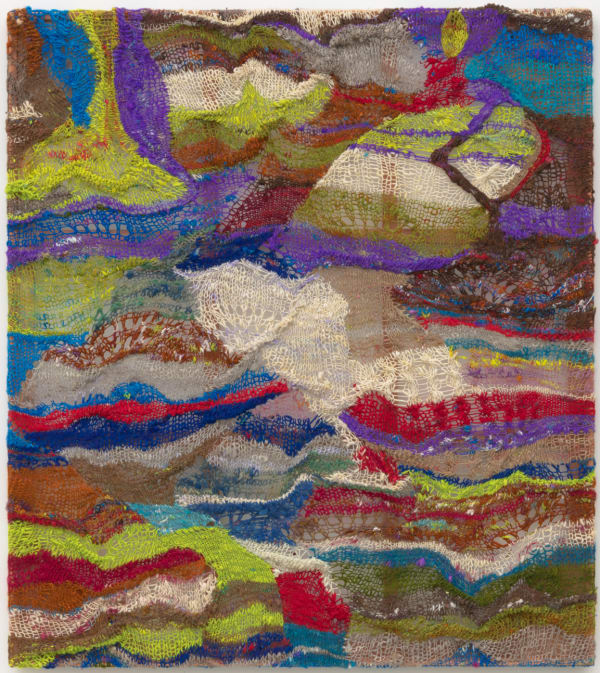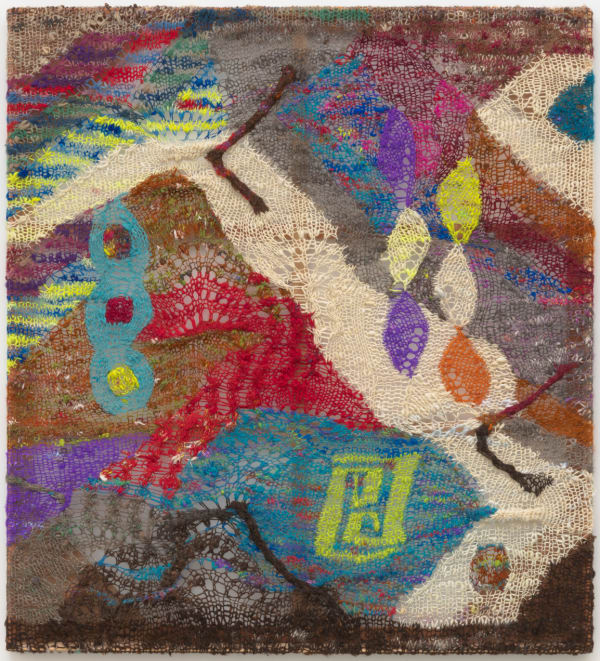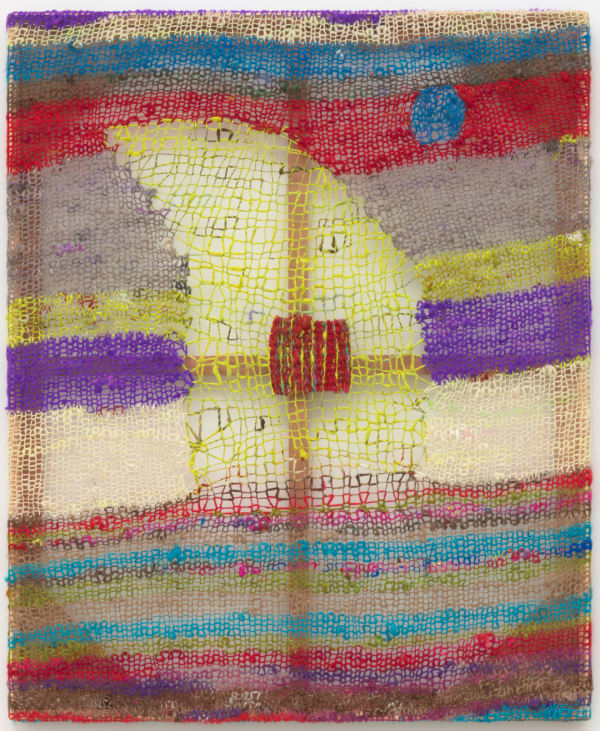-
CHANNING HANSEN
I, ALGORITHM | SUSAN INGLETT GALLERY -
-
Susan Inglett Gallery is pleased to present I, Algorithm, a solo show of work by CHANNING HANSEN from 8 September 2021 through 16 October 2021.
I have long been interested in the idea that humans themselves embody an infinite number of potential algorithms. We imagine things like personal choice and free will determine our behavior; yet we are becoming increasingly aware that everything from our romantic relationships to our political preferences to our sartorial selections can be expressed as and shaped by algorithms. -

CHANNING HANSEN, DEFINED DIVERGENT, 2020
-
These works contain elements from all my previous bodies of work, recombined in both familiar and unexpected ways. The fibers, the stitches, the colors - even the frame dimensions - represent the AI's interpretation of how "I" make my work. The titles use words drawn from all my previous artist statements, randomized and recombined using an algorithm so that they sound like 'Channing Hansen titles.'
— Channing Hansen
DOWNLOAD PRICE LIST -
THE ARTIST'S VOICE
-
1) Notes on I, Algorithm
2) Quote from Norbert Wiener
3) Quote from Jason Lanier
4) Advice from Al Hansen -

CHANNING HANSEN, CONTINUITY FABRIC, 2021
-
CONTINUITY FABRIC
A kinesthetic learner, Channing Hansen took up knitting to keep his restless hands busy and his mental bandwidth optimized. In 2009, a pivotal moment occurred when Hansen's knitting practice and art practice intersected: the artist held up a textile he was working on and saw through its stitches the century-old abacus hanging on his studio wall. This accidental layering of technologies served as something of an epiphany for Hansen :
"It got me thinking about how successful technology disappears. You don't even think about it as technology anymore. Like fiber, like textiles - that's a lot of technology from sheep to sweater."— Channing Hansen
-
-
IN THE PRESS
"The intersection between weaving and science has a long history, one that dates back to Charles Babbage’s nineteenth-century analytical engine (and to Ada Lovelace’s early algorithms for it), which was based on his observations of jacquard looms, the first partially automated weaving machines. To go back much further, even Aristotle knew that technē (or craft) was also a form of knowledge, a way of understanding, and an opening into the unknown. Hansen is the latest in such a lineage, and his constructions are at once marvels of handwork and invitations to contemplate our world from another point of view..."
— Andy Campbell, Artforum
-
-
-
-

CHANNING HANSEN, SCIENCE SUSPENDED, 2021
-
SCIENCE SUSPENDED
Hansen's practice combines a passion for science with a Fluxus enthusiasm for iterative experimentation. A computer programmer for many years, Hansen realizes his work by isolating variables — material, dye color, pattern, stitch — assigning them values, and running those values through a computer program to create the instructions for his next piece. The result is a kind of Fluxus "score," a set of parameters that guides the series without dictating its final result.
Hansen's Fluxus leanings are owed in part to family lineage. His grandfather, Al Hansen, was a founding member of the movement. Friend to Yoko Ono and John Cage, Al Hansen's contributions to Fluxus included performances and the seminal text A Primer of Happenings and Time Space Art. Channing Hansen continues to perform his grandfather's works, and Al's influence can be seen as Hansen prioritizes process and experimentation in pursuit of innovation.
"Artists and scientists are very similar in that they conduct research and discovery to find new knowledge. Good art or great art generates new knowledge. In the words of Walter De Maria, 'Any good work of art should have at least ten meanings.'"— Channing Hansen
-
-
-

CHANNING HANSEN, I, ALGORITHM: INDEX, 2021
-
I, ALGORITHM: INDEX
For each series Channing Hansen creates, he also knits an index. The index is an artwork containing examples of each variable that can be found in the algorithm for the series. I, Algorithm: Index is a grid containing one unit for each of the 25 variables that appear throughout the work in the show. The fibers, colors, stitches, and patterns included in the index appear in countless configurations and combinations across the artworks in I, Algorithm. The index functions as the show's genetic code, expressed in surprising ways across unique individuals.
In fact, genetic drift is both medium and message in Channing Hansen's work. The artist maintains relationships with a small group of conservation-breed sheep farmers, often sourcing wool from the offspring of sheep present in previous generations of work. In tribute to these collaborators, their latin names and given nicknames are present in the materials list of each work.
-
-
-

CHANNING HANSEN, TANGIBLE ENGINE, 2020
-
BIBLIOGRAPHY
The following bibliography provides insight into the rich, varied research that informs Channing Hansen's art practice. These volumes inspired the artwork in I, Algorithm, and continue to drive the artist into new, exciting terrain.
1) Jean-Luc Chabert and Évelyne Barbin, et al. A History of Algorithms: From the Pebble to the Microchip. Berlin and New York: Springer Verlag, 1999.
2) Antonio Damasio. “We Must Not Accept an Algorithmic Account of Human Life,” Huffington Post, 06/28/2016 01:05 pm ET Updated Dec 06, 2017.
3) Ed Finn. What Algorithms Want: Imagination in the Age of Computing. Cambridge, MA: MIT Press, 2018.
4) Al Hansen. A Primer of Happenings & Time/Space Art. New York: Something Else Press, 1965.
5) Yuval Noah Harari. Homo Deus: A Brief History of Tomorrow. New York: Harper Perennial, 2018.
6) Natilee Harren. Fluxus Forms: Scores, Multiples, and the Eternal Network. Chicago: The University of Chicago Press, 2020.
7) Hannah Higgins. Mainframe Experimentalism: Early Computing and the Foundations of the Digital Arts. Berkeley, CA: University of California Press, 2012.
8) Manuel Fontán del Junco, José Lebrero Stals, and Maria Zozaya Álvarez, eds. Geneologies of Art: Or the History of Art as Visual Art. Madrid: Fundación Juan March; Málaga: Museo Picasso Málaga, 2019.
9) Jaron Lanier. You Are Not a Gadget. London: Penguin, 2011.
10) Kassia St. Clair. The Secret Lives of Color. London: John Murray Publishers, 2018.
11) Neal Stephenson. Snow Crash. New York: Del Rey, 2017.
12) Norbert Wiener. Cybernetics: Control and Communication in the Animal and the Machine. New York: Wiley; Paris: Hermann et Cie, 1948.
-

CHANNING HANSEN: i, Algorithm
Past viewing_room













